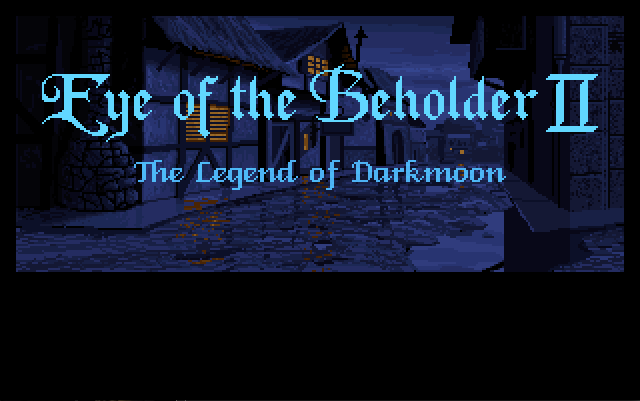


#EYE OF THE BEHOLDER 3 DOS COVER FULL#
So for a priest tanking in the first row with full plate mail, if they're equipped with a holy blessed mace +2 or something they're basically as good as a fighter in the front row with a normal longsword of many levels below them, because they get the near equivalent chance to hit, more free damage AND they also cast spells. on which this game is based, non-martial classes gain hit bonuses at a slower rate to fighters. To further complicate, in ad&d second ed. Α +4 weapon is significantly stronger than a +2 one in that it confers a bonus both to the to-hit roll and to damage.Īs a dungeon master back in the day, the way I used to understand the relative value of a good weapon for a player character is that (simplifying, here) for a warrior a +1 weapon is even better than getting a full level up because that's when they would get a +1 in their to-hit chance, but they also get a +1 in damage that they wouldn't naturally get.Ī fully decked out party with +5 weapons or whatever is basically operating at a threat level 5 levels above what they would with standard armament, when it comes to melee. Surprisingly few survived to be picked up on Amazon or eBay for the type of money I'm willing to pay for them. This is something I'd like to research more on the history of, but buying a lot of these old books is quite expensive. I have a hint book for several Infocom games, as well as two more for Space Quest games that were not officially promoted by the developers. I just got my hands on the Infocom clue book for "Hitchhiker's Guide" (1984) and I was disappointed by just how utilitarian it was.Īnother sign that clue books were big business: there were 3rd party ones. The Space Quest IV hint book, for example, not only had the clues but also a bit of history of the game, pre-production art, and an interview with the developers. I do not know what hint books for cRPGs looked like, but I know that by the early 1990s, adventure game hint books (especially Sierra ones), were frequently quite nice. I am fairly sure that I recall reading Corey say that hint books outsold the games as well. I do not have the link immediately to hand, but your colleague over at the Digital Antiquarian had a post where they pointed out that if Infocom cluebooks were priced higher than paperbacks ($10 in the 1980s?) and would have made the New York Times bestseller lists had such things been allowed. To echo what the others have said, cluebooks were a big business. I'm more interested in the quality of the story than the way it's presented, and while watching the mages cast lightning bolts at Darkmoon until it vanished was cute, it made about as much sense as Khelben's ignorance to the danger posed by Dran Draggore. I mean, I suppose I prefer a cinematic to plain text, but only barely. There were times that the game was difficult, but it did not feature an "insane level of difficulty." And I guess I'm just jaded from modern games, but most reviewers seem to be far more in love with animated introductions and conclusions than I am.

In contrast, I can find nothing to agree with in GameSpy's brief description of the game in a 2004 history of RPGs. He also notes the increase in encounters with role-playing options. My particular approach to playing and mapping doesn't really favor those changes, but I can see why some players would prefer them. He makes a good point on the relative ease of navigation in the sequel, with fewer teleporters and redundant stairways and more hints about secret door locations. Corey "Dingo" Brock offered a retrospective in 2011 on Hardcore Gaming 101.
#EYE OF THE BEHOLDER 3 DOS COVER MANUAL#
Overall, it's clear that like me she prefers games that eschew manual dexterity for more cerebral combat tactics.ĭarkmoon is so well known, of course, that there are plenty of modern takes on the game, too. She also complains about something that I didn't think to complain about but was a problem nonetheless: the need to use the mouse in combat and the keypad to move forces you into an awkward position in which your left hand is on the right side of the keyboard, meaning that your arm is either at a weird angle or you're off-center from the computer monitor. But she agrees with me on the interface issues, quoting a friend in saying, "It's only real-time for the monsters." She bemoans the freezing that accompanies spellcasting and swapping equipment. That highlights how little progress I'm making.) It's not one of her better reviews, full of spoilers and going into unnecessary meticulous detail about a handful of enemies. (I note with some amusement that the same issue has a review of Bloodwych, which I played nearly 6 years and over 200 games ago. Scorpia reviewed Darkmoon in the April 1992 Computer Gaming World.


 0 kommentar(er)
0 kommentar(er)
